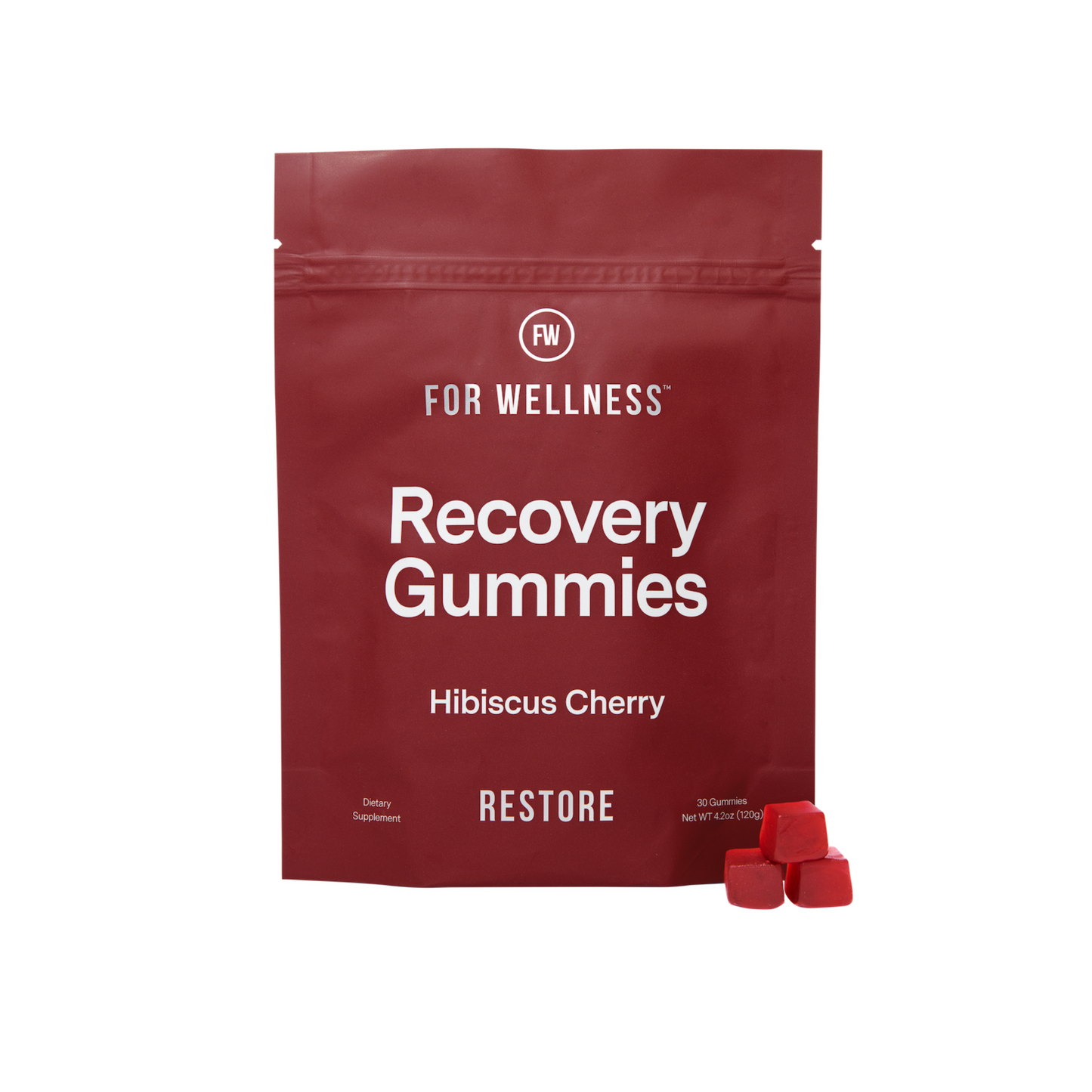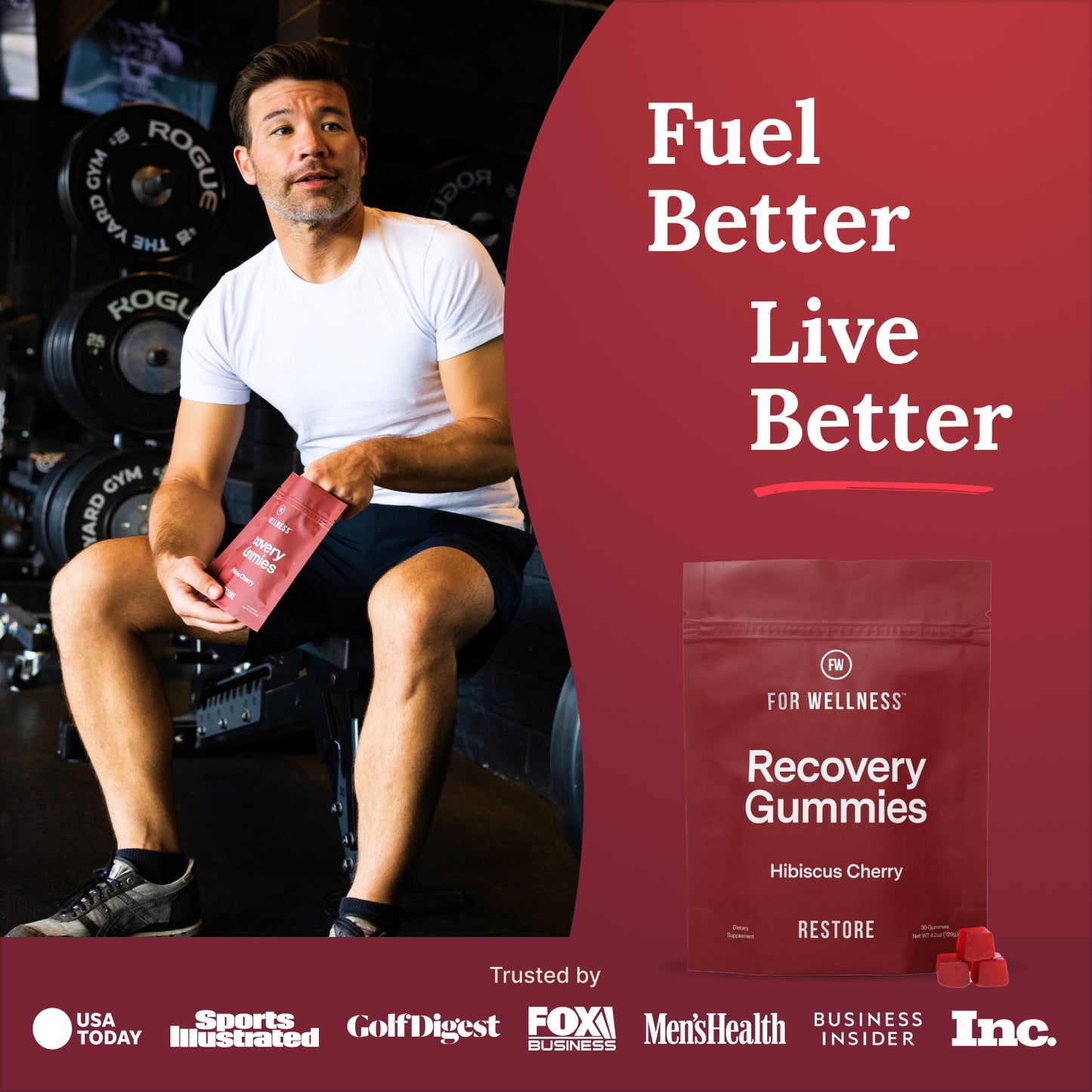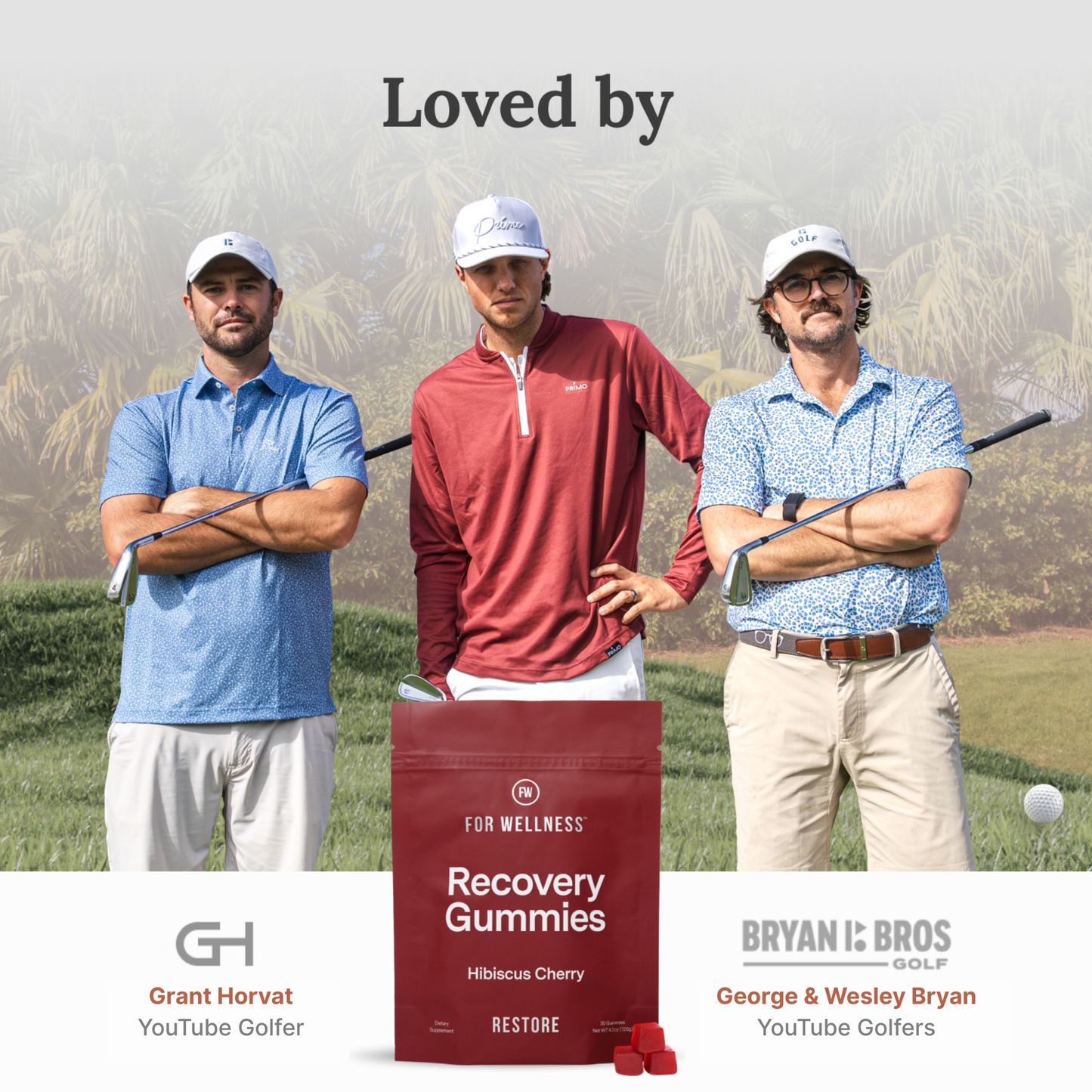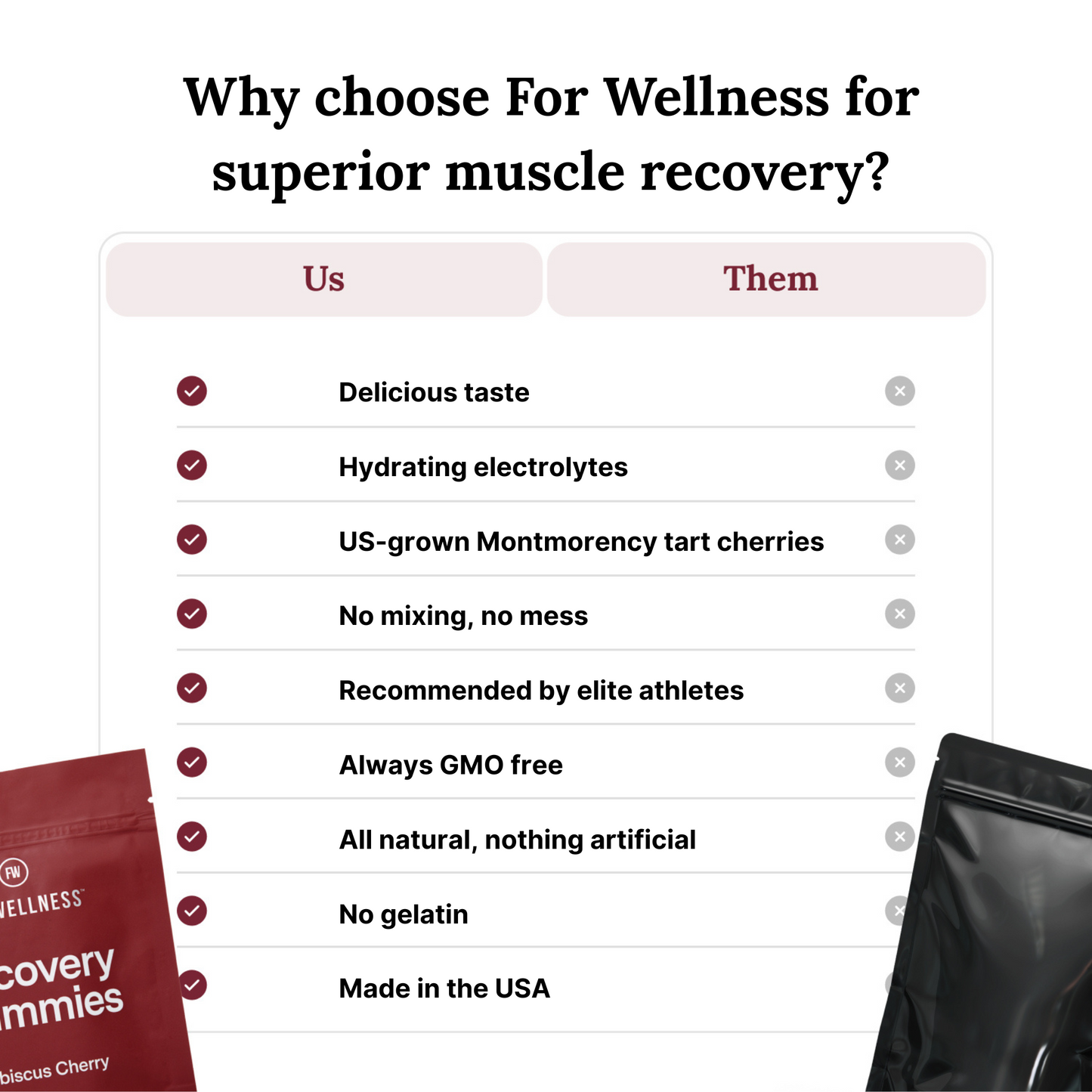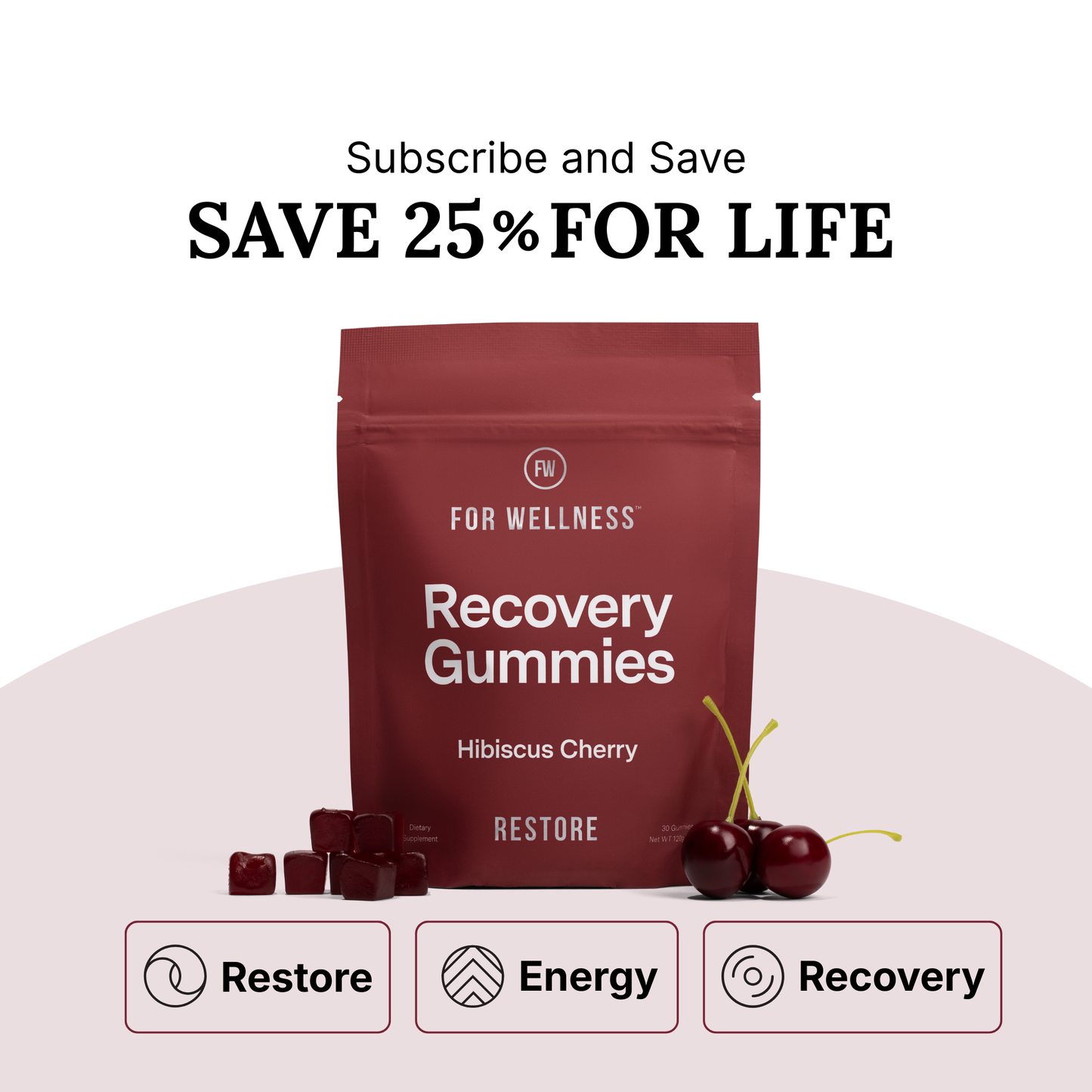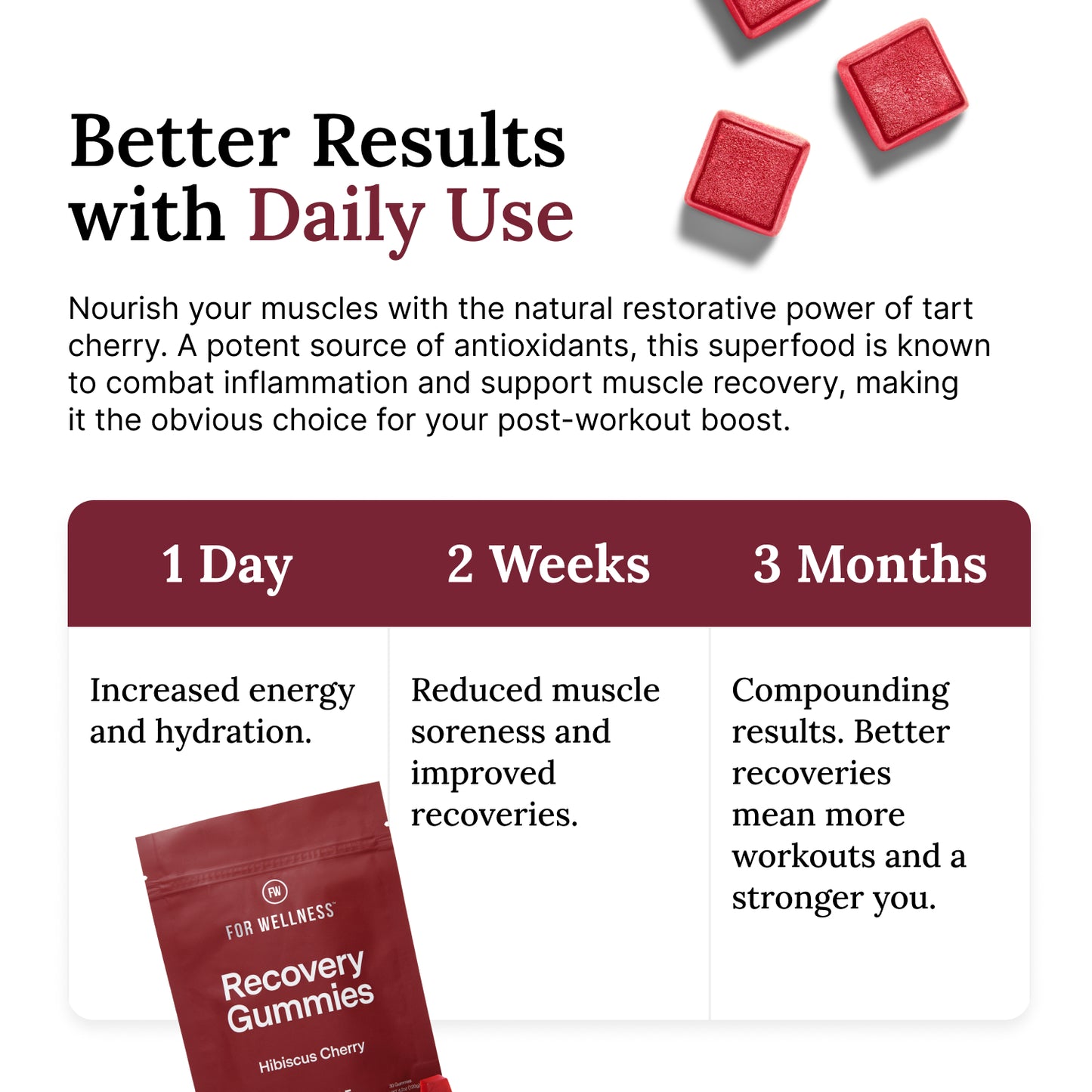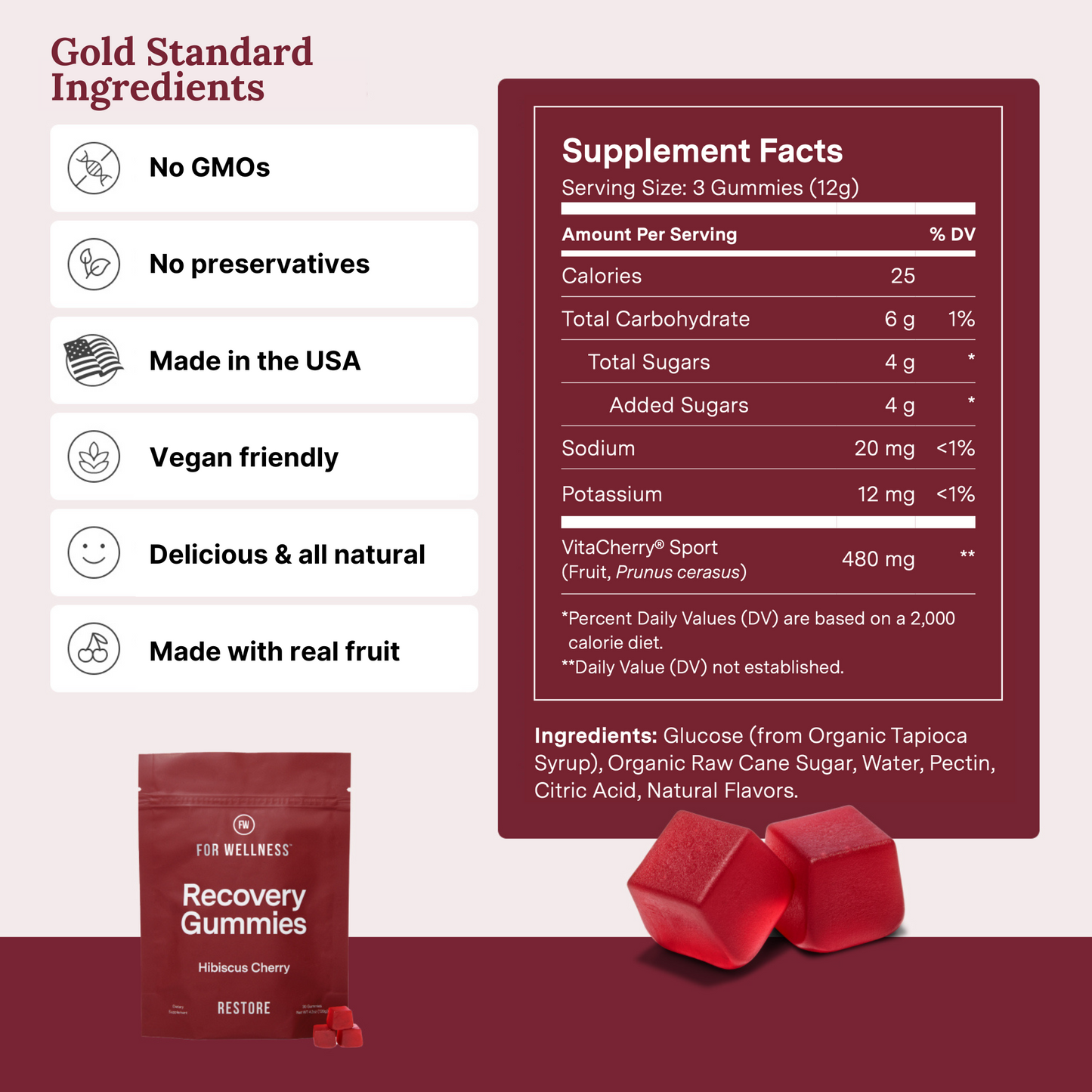While exercise has untold benefits for our body and mind, too much exercise without enough downtime can actually be detrimental to our progress.
To make the most of your rest days, consider giving 'active recovery' a go.
Active recovery is a way of using movement to improve your recovery and performance.
It keeps up momentum on your fitness exercise and is great for mobility, muscle function, and combating muscle soreness.
Below, we've put together some of our favorite active recovery exercises, as well as explaining why you should add active recovery to your routine.


Recovery Gummies - Restore
-
Supports muscle recovery and combats soreness.
-
Full of antioxidants and replenishes electrolytes
-
Boosts energy and focus with all-natural ingredients.
-
Tastes incredible with juicy cherry flavors.
Understanding the Science Behind Exercise Recovery
Exercise recovery plays a crucial role in the body, allowing for muscle repair and growth, restoration of energy stores, and removal of lactic acid.
The Role of Exercise Recovery in the Body
When we exercise, microscopic damage occurs to the muscle fibers. This damage triggers a repair process in the muscles, activating satellite cells and synthesizing new muscle proteins.
When these muscle fibers regenerate, we grow stronger. Woohoo!
However, these processes need time to take effect, hence the need for rest days from exercise.
Rest days also allow your body to re-energize and reset.
Restoring Energy
During exercise, the body relies on carbohydrates stored as glycogen for energy. As exercise continues, glycogen stores deplete (glycogen is the stored form of glucose), and our body's ability to support performance decreases, leading to fatigue.
By pausing for a recovery period and consuming carbohydrates, our body can replenish these glycogen stores and re-energize.
Consider adding a glucose supplement to your post-workout plan, like our tart cherry Recovery Gummies™. They're exclusively formulated with glucose for rapid energy and are handy for muscle soreness and electrolyte replenishment (more on that later!).
Removal of Lactic Acid
Lactic acid is what causes that intense burn when working out and is a result of anaerobic metabolism.
Anaerobic metabolism occurs when the body's demand for oxygen exceeds its supply during exercise.
The accumulation of lactic acid in the muscles can lead to muscle soreness, stiffness, and fatigue.
During recovery, the body clears lactic acid from the muscles by converting it back into glucose or using it as fuel in the aerobic energy system.
This process helps ease the discomfort associated with lactic acid buildup and prepares the muscles for future workouts.
Active vs. Passive Recovery
Active and passive recovery are two approaches to facilitating the body's recuperation after exercise.
Active recovery involves engaging in low-intensity, low-impact physical activities that promote blood flow and help the body remove metabolic waste products.
Passive recovery involves complete rest or inactivity, allowing the body to recover without any added physical exertion.
While both have their merits, research suggests that active recovery can lead to faster restoration of muscle function, reduced muscle soreness, and improved flexibility.
A well-rounded recovery plan should use both active and passive recovery methods for best results.
Active Recovery Techniques
The key to successful active recovery is avoiding over-exerting yourself. While there's no golden number, experts recommend exercising for no more than two-thirds as long as your regular workout and at about 50% intensity.
By combining the exercises below, you can create a well-rounded recovery routine that addresses both your mental and physical health.
Low-Intensity Exercise
Low-intensity exercises are a cornerstone of active recovery, as they're simple and don't require too much technique. The most straightforward option is going for a slow 30-40 minute walk, but you can also cycle or swim.
Just remember not to over-exert yourself!
Dynamic Stretching
Dynamic stretching and mobility exercises are valuable active recovery techniques that improve overall mobility and, in turn, your ability to work out effectively.
Unlike static stretching, dynamic stretching involves gentle, controlled movements that take the joints and muscles through their full range of motion, promoting blood flow and reducing muscle stiffness.
Try these stretches on your next rest day:
Leg Swings:
- Forward Leg Swings: Stand next to a wall or sturdy support. Swing one leg forward and backward, keeping it straight while maintaining a stable core. Repeat for a set number of reps and switch legs.
- Side Leg Swings: Similar to forward swings, but swing the leg out to the side, engaging your hip abductor muscles.
Arm Circles:
- Stand with your feet shoulder-width apart and extend your arms straight out to the sides. Make small circles with your arms, gradually increasing the size of the circles.
Walking High Knees:
- As you walk forward, lift your knees up toward your chest as high as possible, alternating legs with each step. Engage your core and use your arms to help with momentum.
Walking Butt Kicks:
- While walking forward, flex your knee and kick your heel up towards your glutes. Alternate legs with each step.
Walking Lunges with a Twist:
- Take a step forward into a lunge position, then rotate your torso and arms over the front leg. Return to the starting position and repeat on the other side.
Inchworms:
- Stand with your feet hip-width apart. Bend at the waist and place your hands on the ground. Walk your hands forward until you are in a plank position. Then, walk your feet forward towards your hands. Repeat the movement.
Spiderman Stretch:
- Start in a push-up position. Step your right foot forward, placing it outside your right hand. Drop your hips and gently twist your torso to the right. Return to the starting position and repeat on the other side.
Carioca or Grapevine:
- Stand with your feet together. Cross your right foot over your left and step to the side. Then, step your left foot behind your right. Continue this side-to-side movement.
Dynamic Chest Opener:
- Interlace your fingers behind your back. Straighten and raise your arms while squeezing your shoulder blades together. Hold for a moment, then release.
Ankle Circles:
- Lift one foot off the ground and make circles with your ankle in one direction, then switch to the other direction. Repeat on the other foot.
Remember to perform each movement in a controlled manner, and do not force your body into any uncomfortable positions. If you're unsure about the suitable stretches for your specific activity, consider consulting a fitness professional or coach.
Mobility exercises, such as hip openers or thoracic spine rotations, can also be incorporated into an active recovery routine to address joint mobility and movement patterns.
Yoga and Pilates
Yoga and pilates help improve balance, proper alignment, core stability, and breath control.
If you don't want to take a class at your gym, try an online session.
Both yoga and pilates can be easily adapted to suit your needs and preferences, with a wide variety of styles and intensities available.
Foam Rolling and Self-Myofascial Release
Foam rolling and self-myofascial release are active recovery techniques that can alleviate muscle soreness, release tension and improve flexibility.
You can use a range of tools for self-myofascial release, including foam rollers, massage balls, and massage guns.
You can use these to apply pressure to specific areas of muscle tightness or discomfort, promoting relaxation and increased blood flow.
Aquatic Therapy and Water-Based Exercises
Aquatic therapy and water-based exercises are unique active recovery techniques that can provide several benefits due to water's buoyancy and resistance properties.
Swimming, water aerobics, and aqua jogging are all kinds of aquatic therapy.
It can help promote blood flow and muscle relaxation while minimizing the impact on joints and connective tissues.
The hydrostatic pressure of water can also help reduce inflammation and facilitate the removal of metabolic waste products, further enhancing the recovery process.
Optimizing Active Recovery Sessions
When Should I Engage in Active Recovery
Ideally, try to space out your active recovery days, with about 1-2 per week.
While anywhere between 20-40 minutes is perfect for a session, listen to your body and adjust the timing and duration of active recovery sessions so you're not overdoing it.
Choosing the Appropriate Intensity and Volume
Selecting the appropriate intensity and volume for active recovery sessions is crucial to ensure optimal recovery without overtaxing the body.
Active recovery activities should be low in intensity, focusing on maintaining a comfortable pace that promotes blood flow and relaxation without causing additional muscle strain.
The volume of activity during active recovery should also be lower than your regular workouts, allowing for adequate rest and recuperation.
Also, consider your heart rate, exertion, and overall comfort during active recovery sessions to gauge the appropriate intensity and volume for your needs.
Remember, active recovery is supposed to support your overall exercise regime. If you're feeling extremely fatigued and impacting your fitness, consider reducing your active recovery intensity.
Incorporating Variety and Enjoyment
Incorporating variety and enjoyment into active recovery sessions can help maintain motivation and adherence to a routine.
For example, going for long walks can be a great time to phone a family member or catch up with a friend.
Ensuring that active recovery activities are enjoyable can foster a positive mindset and promote long-term adherence to a recovery plan.
Nutrition and Hydration After Exercise
Proper nutrition and hydration play a critical role in active recovery, providing the essential building blocks and energy required for the body to repair and regenerate.
A well-rounded nutrition and hydration plan can significantly enhance the effectiveness of active recovery techniques and contribute to a more sustainable and enjoyable fitness journey.
Macronutrients for Recovery
Macronutrients include carbohydrates, proteins, and fats.
They are essential for active recovery as they give the energy and materials needed for muscle repair and growth.
Carbohydrates are crucial for replenishing glycogen stores, which we learned, can become depleted during intense exercise. Consuming adequate carbohydrates can help prevent excessive muscle breakdown and support recovery.
Protein is necessary for muscle repair and synthesis, providing the amino acids needed to rebuild damaged muscle tissue. Healthy fats, such as omega-3 fatty acids, can help reduce inflammation and support health during the recovery process.
Ensuring a balanced intake of macronutrients can enhance the effectiveness of active recovery sessions and contribute to performance.
Hydration and Electrolyte Replenishment
Maintaining proper hydration and electrolyte balance is vital for active recovery, as it supports bodily functions, including temperature regulation, nutrient transport, and waste removal.
During exercise, the body loses fluids and electrolytes through sweat, leading to dehydration and impaired performance if not replenished.
Consuming water and electrolyte-supplements, like our Recovery Gummies™ (which contain sodium and potassium) during and after exercise can help restore fluid balance and promote optimal recovery.
Importance of Micronutrients
Micronutrients, such as vitamins and minerals, play a crucial role in active recovery by supporting physiological repair and growth.
For example, vitamins C and E act as antioxidants, helping to reduce oxidative stress and inflammation caused by exercise.
Minerals like calcium, magnesium, and potassium support bone health, muscle function, and electrolyte balance.
Enjoy fruits, vegetables, whole grains, lean proteins, and healthy fats like avocado to optimize post-exercise recovery.
As mentioned, our Recovery Gummies™ are specially designed to incorporate some of these crucial nutrients for better recovery. Each gummy contains tart cherry (an antioxidant that is great for muscle soreness, strength, and combating inflammation in relation to exercise), electrolytes to replenish your stores, and glucose for energy.
Nutrient Timing
Even the exact time you eat during post-exercise recovery plays a role in its efficacy.
A balanced meal or snack containing carbohydrates and protein within 30-60 minutes after exercise is great for maximizing glycogen replenishment and muscle repair.
Additionally, staying hydrated before, during, and after exercise is essential for maintaining optimal fluid balance and promoting effective active recovery.
The Role of Hormones and Inflammation in Recovery
Growth hormones, testosterone, and insulin-like growth factor 1 (IGF-1) play a pivotal role in muscle repair and growth by stimulating protein synthesis, activating satellite cells, and promoting new muscle fibers' formation to enhance muscle strength and performance.
Inflammation is another critical factor in recovery. It is a natural immune response to tissue damage caused by exercise.
Acute inflammation is necessary for initiating the repair process. However, prolonged or excessive inflammation can impede recovery and increase the risk of injury.
Combat exercise-induced inflammation by adding tart cherry supplements to your post workout, and support this effort with a good night's sleep.
Benefits of Active Recovery
The benefits of active recovery are manifold, contributing to improved physical and mental well-being.
Engaging in low-intensity exercises during active recovery helps to enhance muscle function by promoting blood flow and facilitating the removal of metabolic waste products.
This process reduces muscle soreness and stiffness, allowing for faster recovery.
Improved Muscle Function
By engaging in low-intensity exercises during the recovery period, you can promote increased blood flow to the muscles. This delivers essential nutrients and oxygen required for repair and regeneration.
Enhanced circulation aids in the removal of metabolic waste products. As we mentioned above, lactic acid leads to feelings of fatigue, stiffness, and soreness.
The gentle movements help support and improve the range of motion around joints. Contributing to better mobility and athletic performance.
Increased Flexibility and Mobility
Active recovery significantly promotes increased flexibility and mobility, which are essential to fitness and injury prevention. Engaging in activities such as dynamic stretching, yoga, and pilates.
These forms of active recovery are best for lengthening muscles, improving joint range of motion, and easing muscle imbalances that may develop over time.
Improved flexibility and mobility not only contribute to better athletic performance but aid in maintaining functional movement and balance in daily life.
Reduced Muscle Soreness and Stiffness
One of the primary benefits of active recovery is the reduction of muscle soreness and stiffness that often occurs after intense workouts.
As mentioned above, you can enhance blood flow to the muscles, facilitating the delivery of essential nutrients and the removal of metabolic waste products. This process helps ease discomfort and inflammation associated with delayed onset muscle soreness (DOMS).
Support this by eating foods that also help with muscle soreness. Tart cherry is excellent for combating muscle fatigue, soreness, and inflammation associated with exercise.
Here at For Wellness, we have specialized tart cherry Recovery Gummies™, which are specially designed to taste delicious and aid recovery, but they also contain electrolytes and glucose for energy.
The Role of Sleep in Active Recovery
The Importance of Sleep for Recovery
Sleep is a critical part of the recovery process, as it is during this time that the body undergoes many restorative processes essential for optimal health and performance.
During sleep, the body releases growth hormones. They ease the removal of metabolic waste products accumulated during exercise.
Sleep is vital for cognitive functions like learning, memory, and decision-making.
This can influence athletic performance and well-being. Prioritizing sleep and ensuring adequate duration and quality can enhance active recovery and support long-term fitness goals.
Strategies for Improving Sleep Quality
To maximize the benefits of sleep for active recovery, try some of these strategies:
- Establishing a consistent sleep schedule
- Creating a relaxing bedtime routine
- Optimizing your sleeping environment
- Comfortable bedding
- Cool room temperature
- Minimal noise and light
- Limiting exposure to electronic devices before bedtime
You can contribute to better sleep quality by:
- Engaging in regular physical activity
- Managing stress
- Avoiding excessive caffeine and alcohol intake
Adopting these sleep-promoting habits can support your active recovery process and health and well-being.
How Can For Wellness Help?
If you're serious about nailing your post-exercise recovery, you've got to try out tart cherry Recovery Gummies™.
Formulated with a potent tart cherry extract to combat muscle soreness and post-exercise inflammation, plus glucose for energy and electrolytes for hydration, they're an absolute must for athletes of any level.
Still have questions? Don't hesitate to contact us at info@forwellness.com.



